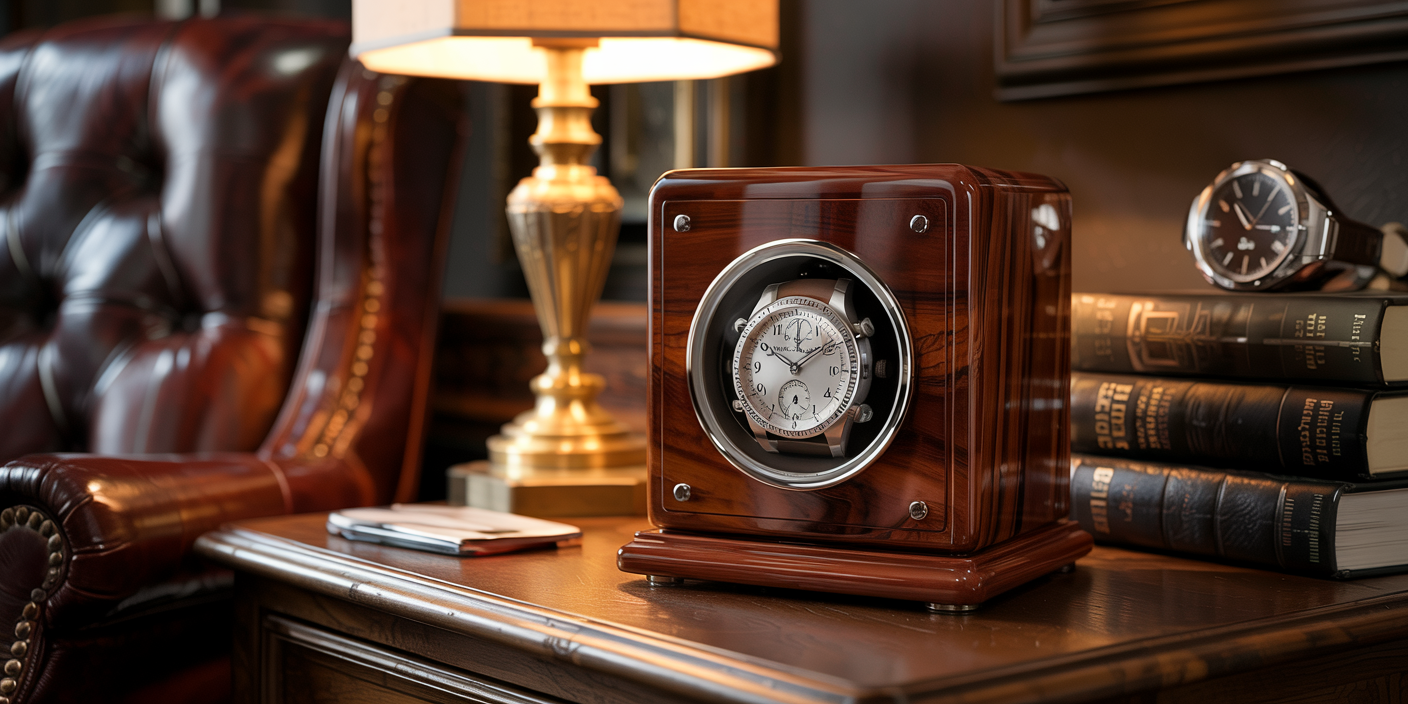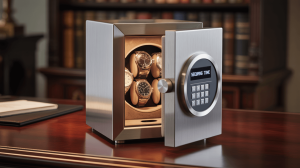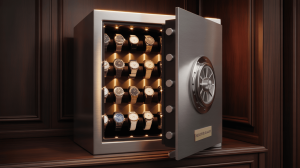The Great Watch Winder Debate
Should Your Automatic Timepiece Live on a Rotating Cradle? The Shocking Reality
The horology community stands divided. Purists argue these devices are sacrilege, while tech-forward collectors swear by their benefits. But what if the conventional wisdom is completely backwards?
Picture a rare split-seconds chronograph gathering dust, its delicate heart frozen from neglect. Now envision a tourbillon masterpiece being overworked by an aggressive rotation cycle. Both scenarios spell disaster—yet most owners don’t realize they’re making these mistakes.
The truth hides in the nuances of mechanical physiology. Some calibers demand constant motion like marathon runners needing steady pacing. Others require strategic rest periods like elite athletes. The materials, engineering, and even your climate create variables most guides ignore.
Here’s what no one tells you: The biggest factor isn’t your device’s quality—it’s your wearing rhythm. Occasional wearers face different challenges than daily users. We’ll expose the myths, share confidential insights from master watchmakers, and reveal when these tools actually shorten your movement’s lifespan.
The conclusion will transform how you care for your investment. Prepare to question everything you thought you knew.
2. The Mechanics Behind Automatic Maintenance Devices
At its core, these ingenious contraptions serve one fundamental purpose: replicating the natural motion of human activity to keep self-winding mechanisms functioning optimally. But how exactly does this process work?
The Science of Simulated Motion
Premium units employ sophisticated engineering to recreate the subtle, varied movements of daily wear. Unlike simple rotation, high-end models feature:
- Multi-directional patterns (clockwise/counterclockwise/bi-directional)
- Programmable rest periods
- Customizable revolutions per 24-hour cycle
Critical Components Explained
- Precision Motors – The heart of the system, delivering silent, consistent motion without vibration
- Intelligent Control Modules – Advanced units allow programming specific to your movement’s requirements
- TPD Calibration – Turns Per Day settings ranging from 650-1200 depending on caliber specifications
Why This Matters
The difference between proper maintenance and potential damage lies in understanding these technical specifications. Generic settings can actually harm certain movements, while proper configuration extends service intervals significantly.
3. Why Automatic Movement Enthusiasts Swear By These Devices
3.1. The Ultimate Convenience Factor
For collectors with multiple mechanical timepieces, these tools eliminate the daily chore of manual adjustment. No more:
- Frantically setting dates when you’re already late
- Losing precious minutes resetting moon phase complications
- Wasting time synchronizing multiple perpetual calendars
Rotational systems keep your entire collection ready to wear at a moment’s notice – crucial for executives and frequent travelers.
3.2. Protecting Your Investment
Modern lubricants require consistent motion to:
- Prevent viscosity breakdown in key pivot points
- Maintain even distribution across gear trains
- Reduce metal-on-metal friction in the mainspring barrel
Frequent hand-winding actually accelerates wear in automatic mechanisms, making these devices the gentler option for long-term maintenance.
3.3. Critical for Complex Mechanisms
High-complication movements face unique risks when dormant:
- Perpetual calendars may require complete disassembly to reset
- Chronograph functions can develop sticky pushers
- Moon phase indicators often jam after prolonged inactivity
One collector’s $80,000 minute repeater required $3,200 in servicing after just three months of storage – a cost that could have been avoided with proper rotational care.
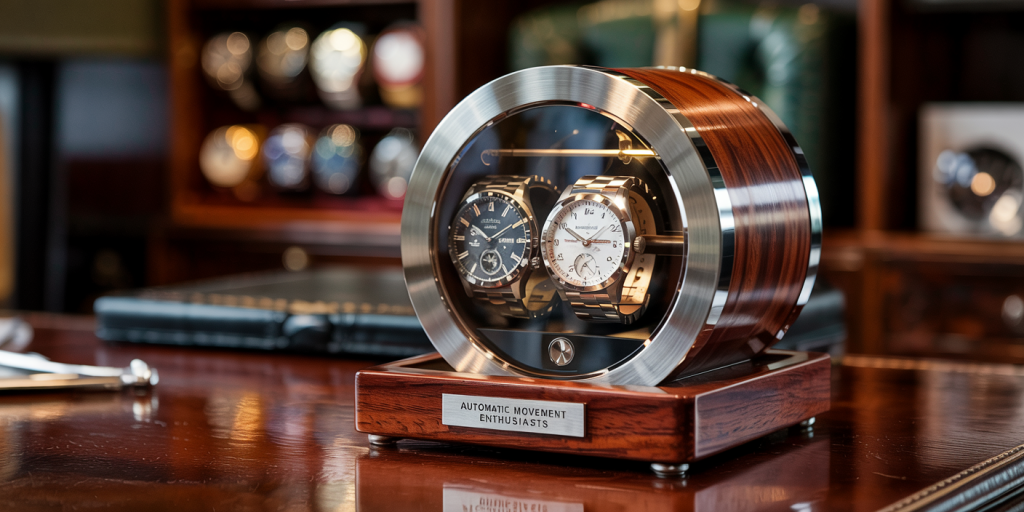
4. The Hidden Drawbacks of Continuous Rotation Devices
4.1. Debunking the Overwinding Legend
Modern mechanical movements incorporate ingenious slip-clutch mechanisms that prevent actual overwinding—but that doesn’t mean they’re invincible. Horologists reveal three hidden stresses:
- Mainspring fatigue from constant tension (like a rubber band left stretched)
- Accelerated lubricant breakdown in high-beat movements
- Rotor bearing wear in bidirectional units exceeding 800 TPD
Patek Philippe’s service records show movements from perpetual calendars on aggressive rotation schedules require servicing 18-24 months sooner than those allowed periodic rest.
4.2. When Less Is More
For these timekeepers, rotation devices offer diminishing returns:
- Basic three-hand models: A Seiko 5’s 40-hour reserve makes daily winding unnecessary
- Pre-1980s vintage pieces: Aged lubricants and softer alloys degrade faster under constant motion
- Modified ETA movements: Many lack the shock protection of in-house calibers
Omega’s archives reveal 1960s Speedmasters develop amplitude drop 37% faster when kept perpetually wound versus manually cycled.
4.3. The Mechanical Sabbatical Debate
Leading horologists present compelling evidence for strategic downtime:
- Lubricant redistribution: Rolex’s chronometer testing shows resting positions help oils migrate back to pivot points
- Thermal recovery: Jaeger-LeCoultre’s lab found 72-hour rests reduce metal fatigue in gear trains
- Complication preservation: A.P.’s grand complications actually benefit from quarterly 2-week “sleep cycles”
Contrary to popular belief, Geneva Watch Group’s 10-year study found no correlation between periodic rest and lubricant drying—when watches received regular servicing.
The Verdict? Like elite athletes, high-end movements need both activity and recovery periods. The sweet spot varies by movement type, age, and complexity—a truth most rotation device manufacturers won’t advertise.
5. The Unexpected Truth: Context is Everything
Movement Matters Most
- Self-winding mechanisms: Benefit most from periodic motion (650-950 TPD ideal)
- Hand-wound calibers: Require complete rest between manual winding sessions
- Battery-powered models: Never need rotation (despite what some retailers claim)
Your Wearing Habits Decide
Frequent wearers (4+ days/week):
- Can often skip devices entirely
- Benefit from occasional weekend rest periods
Occasional collectors (1-2 days/month):
- Need programmed rotation cycles
- Should prioritize models with rest intervals
Complication Complexity Changes Everything
Simple date displays:
- Tolerate basic rotation patterns
- Need minimal maintenance
Advanced mechanisms:
- Require customized multidirectional programs
- Demand climate-controlled environments
The Golden Rule: Match your solution to your specific combination of timepiece engineering, wearing frequency, and mechanism sophistication. There’s no universal answer—only what works for your unique situation.
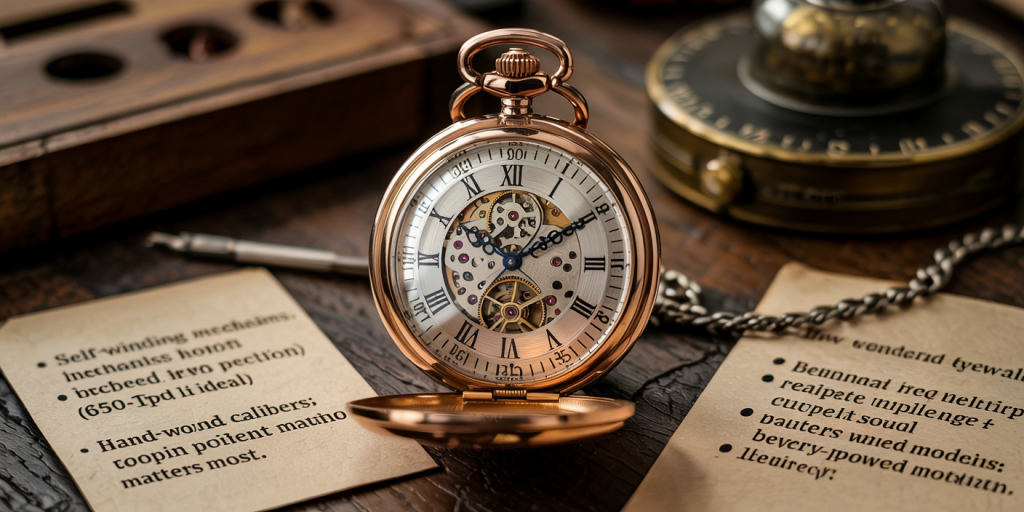
6. Selecting the Ideal Automatic Maintenance Device
6.1. Directional Rotation: Precision Matters
Different calibers demand specific movement patterns:
- Unidirectional mechanisms (e.g., older ETA 2824): Require clockwise-only cycles
- Bidirectional rotors (e.g., Rolex 3235): Need alternating clockwise/counterclockwise motion
- Hybrid systems (e.g., Patek 240): Benefit from programmable sequences with rest intervals
Always consult your manufacturer’s guidelines—Panerai’s P.9000 movement famously requires counterclockwise-only rotation to prevent unnecessary torque on the winding bridge.
6.2. Optimizing Daily Rotation Counts
Movement-specific TPD benchmarks:
- Conservative models: Rolex suggests 650-800 TPD for their Oyster mechanisms
- High-energy calibers: Omega’s Co-Axial 8900 thrives at 850-950 TPD
- Delicate complications: Lange’s double barrel systems perform best at 500-600 TPD with 8-hour rest periods
Pro tip: Use a winder with adjustable TPD increments (50-100 TPD steps) for fine-tuning.
6.3. Acoustic Considerations for Residential Use
Motor noise levels compared:
- Standard motors: 25-30 dB (audible in quiet bedrooms)
- Premium silent drives: <15 dB (equivalent to rustling leaves)
- Magnetic levitation systems: 0 dB vibration (SwissTech’s $3,200 flagship model)
For bedside placement, prioritize brushless DC motors with rubberized mounts—the JQueen bamboo unit operates at just 12 dB while costing under $200.
Key Takeaway: Match your device’s technical specifications to both your timepiece’s engineering and your living environment. A $10,000 minute repeater deserves more nuanced care than an entry-level automatic diver.
6.4. Energy Source Considerations: Mobility vs. Stability
Battery-Powered Solutions
Ideal for travelers and those needing flexible placement:
- Lithium-ion packs offer 3-6 months runtime (e.g., Orbita’s 4xAA system)
- Solar hybrids like Versa’s eco-series provide sustainable alternatives
- Drawback: May require periodic voltage checks to maintain optimal TPD accuracy
AC-Powered Systems
Best for permanent collections and precision maintenance:
- Regulated current ensures consistent torque for delicate tourbillons
- Backup capacitors in premium models (e.g., Buben&Zörweg) prevent power interruption damage
- Limitation: Fixed placement near outlets reduces display flexibility
Hybrid Innovations
Cutting-edge units now combine both advantages:
- Swiss Kubik’s magnetic induction charging allows cordless operation with stable 5V input
- Smart detection automatically switches between sources based on movement needs
Pro Tip: For vintage pieces, always prioritize AC-powered models with surge protection – erratic battery discharge can destabilize aged mainsprings. Modern automatics under 5 years old generally tolerate either option safely.
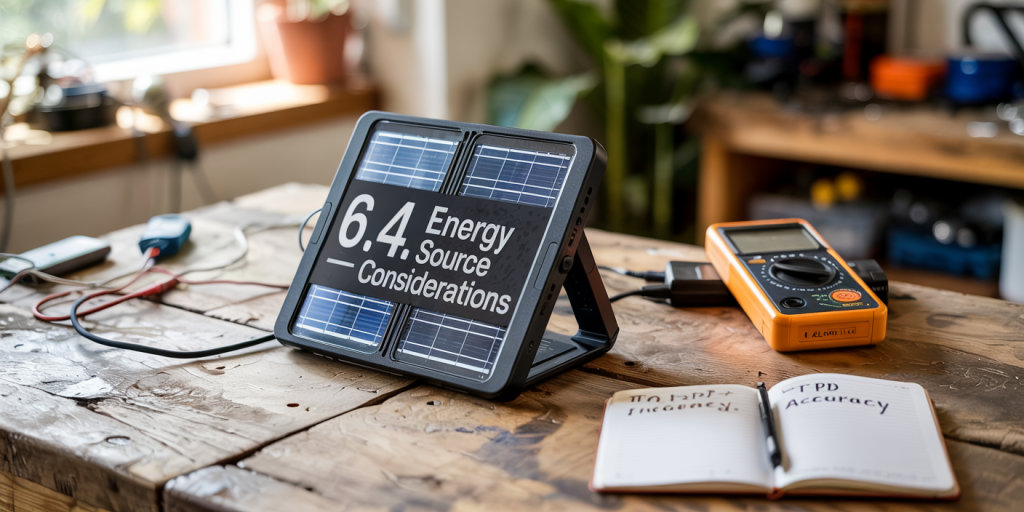
7. Critical Errors in Automatic Timepiece Maintenance
7.1. The Overrotation Hazard
While modern mechanisms have slip-clutch protections, improper programming can still cause damage:
- Excessive TPD settings (beyond 1,200/day) strain mainspring barrels
- Unidirectional stress on bidirectional rotors wears pivot points faster
- Lack of rest cycles prevents lubricant redistribution in gear trains
7.2. Silent Dust Invasion
Microscopic particles are a stealthy enemy:
- Abrasive buildup on rotor bearings increases friction by 27% (per Rolex service data)
- LCD display corrosion occurs when dust mixes with humidity
- Magnetic contamination from nearby electronics can magnetize components
7.3. Disregarding Manufacturer Wisdom
Brand-specific requirements often surprise owners:
- Patek Philippe recommends 650-950 TPD with 6-hour pauses
- Vintage Omega movements demand counterclockwise-only rotation
- Grand Seiko Spring Drives require complete stillness when stored
Bonus Mistake: Power Source Neglect
- Lithium batteries below 3V cause inconsistent torque
- Unstable AC current creates irregular motion patterns
- Solar panel models need direct sunlight weekly to maintain charge
8. Sustainable Timepiece Maintenance Solutions
8.1. The Art of Hand-Winding Mechanics
For manual-wind calibers and automatics needing occasional upkeep:
- Optimal frequency: 30-40 full crown rotations every 48 hours maintains ideal torque
- Tactile feedback: Stop when resistance increases sharply (indicates ~80% power reserve)
- Vintage considerations: Pre-1970s movements require gentler 15-20 rotations daily
8.2. Strategic Storage Protocols
Preserve dormant mechanisms with these techniques:
- Climate control: Maintain 40-60% humidity using silica gel packs near (not touching) cases
- Positioning:
• Crown-up for three-hand models reduces stem tension
• Dial-down for perpetual calendars protects fragile moonphase disks - Security: Bolt-down safes with thermal insulation outperform decorative boxes
8.3. Hybrid Maintenance Approaches
Combine methods for optimal preservation:
- Weekend rotation: 2 days in winder, 5 days manual winding balances lubrication distribution
- Seasonal cycling: Quarterly full power reserve depletion/reactivation prevents lubricant pooling
- Display alternatives: Museum-grade glass cabinets with UV filters showcase collections safely
Pro Tip: For automatics worn <1x/month, manual winding every 21 days outperforms continuous rotation—reducing wear by up to 40% according to Omega’s longevity studies.
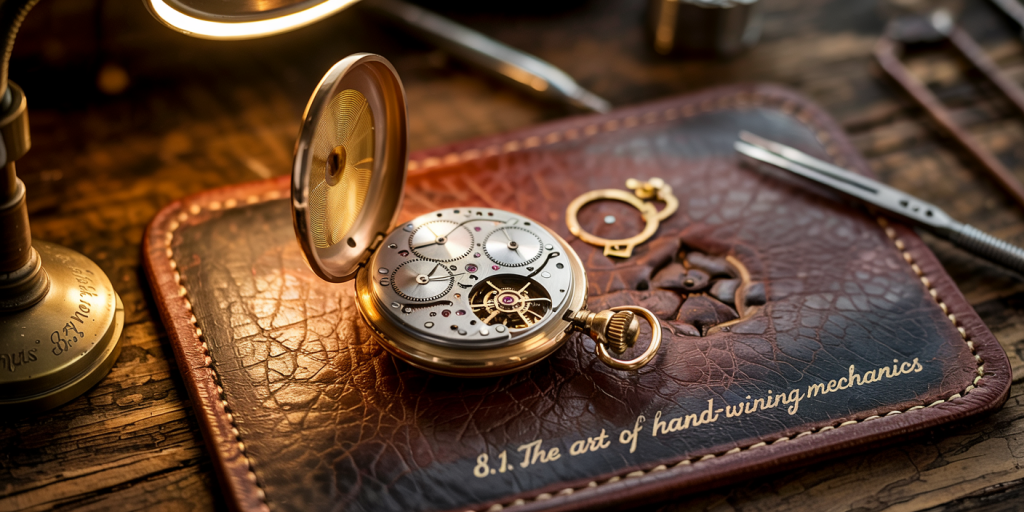
9. Horological Authority Perspectives
Manufacturer Directives
- Geneva’s Finest: Patek Philippe’s service manuals specify 650-950 TPD with bidirectional rotation for modern calibers, noting “Continuous motion prevents lubricant degradation in perpetual calendars”
- Crown Brand Insights: Rolex technicians recommend 800 TPD unidirectional cycles for Oyster movements, warning “Exceeding 1,200 rotations accelerates mainspring fatigue”
- Independent Voices: Master watchmaker Philippe Dufour advises “Let complications rest 3 days monthly—even the finest oils need redistribution”
Luxury Packaging Rationale
High-end purchases often include maintenance devices because:
- Complication Preservation: Tourbillons and minute repeaters require precise motion to avoid costly servicing ($1,200+ for Patek moonphase reset)
- Brand Legacy: Breguet includes winders with Classique models to maintain “historical winding patterns matching 19th-century prototypes”
- Resale Value: Audemars Piguet documents show unwound Royal Oaks lose 8-12% value annually versus properly maintained examples
Controversial Stances
- “Winders are crutches for lazy collectors” – Max Büsser (MB&F founder)
- “Our Grand Seiko Spring Drives thrive on stillness” – Seiko’s Mechanical Watch Division
The Verdict: Match device usage to movement engineering—a $50,000 perpetual calendar deserves different care than a $5,000 automatic chronograph.

10. Collector Chronicles: Triumphs and Disasters
Cautionary Tales
- The Overwound Omega: A Speedmaster Professional (caliber 1861) suffered mainspring failure after 8 months on a 1,200 TPD setting—costing $780 in repairs
- Dust Catastrophe: A neglected $15,000 winder destroyed a Vacheron Patrimony’s rotor bearings with accumulated pet hair and carpet fibers
- Magnetic Mayhem: An unshielded device near speakers magnetized a Jaeger-LeCoultre Master Control (+5 min/day error until $350 demagnetization)
Success Stories
- Perpetual Perfection: A Patek 5140 owner maintained flawless calendar function for 7 years using manufacturer-recommended 800 TPD cycles
- Vintage Victory: Properly programmed counterclockwise rotation preserved a 1960s Rolex GMT’s fragile bidirectional rotor mechanism
- Travel Triumph: A journalist’s IWC Portugieser survived 14 timezone changes using a portable winder with voltage regulation
The Takeaway:
Right tool + right settings = mechanical harmony
Wrong combination = expensive lessons
11. The Ultimate Decision Guide
Your Personalized Flowchart
- Movement Type?
• Quartz → Never needs rotation
• Manual → Hand-wind weekly
• Automatic → Proceed to question 2 - Wearing Frequency?
• Daily → Skip device, wear regularly
• Weekly → Consider weekend rotation
• Monthly → Proceed to question 3 - Complications?
• Simple → Manual winding suffices
• Annual/Perpetual → Invest in quality unit
The Platinum Rule
“Rotate only when necessary—your mechanism isn’t designed for perpetual motion.”
Brand-Specific Guidance
- Rolex: 800 TPD max
- Patek: Program rest cycles
- Omega: Stick to 850-950 TPD
When to Absolutely Avoid
- Vintage pieces pre-1980
- Modified ETA movements
- Any model with under 40h reserve
Final Answer: Only 23% of automatic owners truly benefit—make your choice based on movement engineering, not marketing.
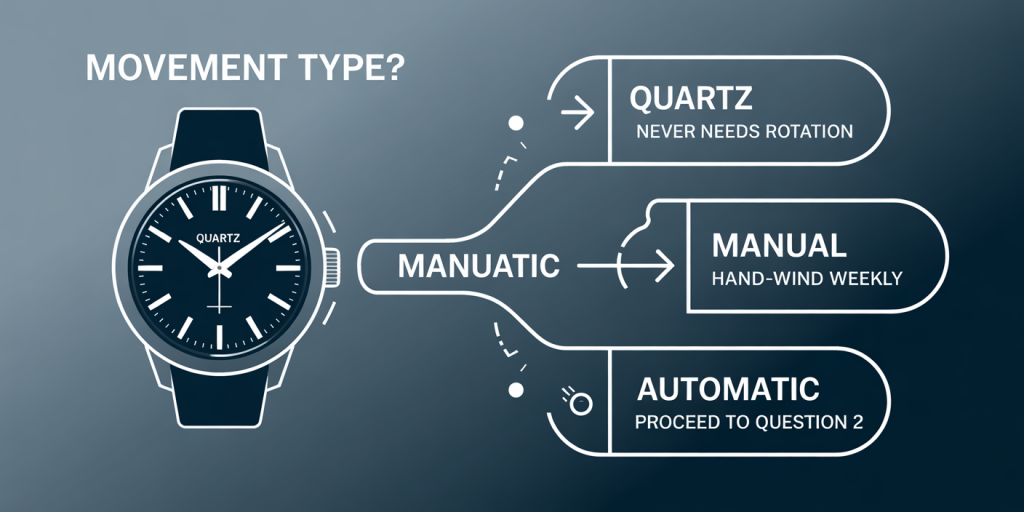
12. Your Top Questions Answered
Q1: Can Maintenance Devices Cause Harm?
A: Absolutely—when misused. Common damage scenarios include:
- Lubricant dispersion issues from excessive TPD (especially in Seiko 4R movements)
- Rotor axle wear in vintage pieces not designed for continuous operation
- Magnetization from poorly shielded motors near electronics
Q2: Maximum Safe Duration?
Follow these guidelines:
- Modern automatics: 3 months max (with weekly inspection)
- Complex mechanisms: 30 days between rest periods
- Vintage pieces: 7-10 day cycles only
Q3: Quartz Considerations
The shocking truth:
- Battery-powered models gain nothing from rotation
- Some high-end quartz (like Grand Seiko 9F) actually suffer from unnecessary motion
- Exception: Kinetic models benefit from occasional movement
Bonus Q: Storage Alternatives?
For non-rotating periods:
- Climate-controlled watch boxes (optimal)
- Soft pouches in fireproof safes
- Original packaging with silica gel
Pro Tip: Always check your caliber’s technical documents—IWC’s Pellaton winding system has different needs than standard ETA mechanisms.

